Looking at The Big Picture: Earnings and Valuations
Don't look now fans, but the number of trading days left in calendar year 2019 are dwindling fast and the holiday season is right around the corner. How the heck did that happen?
It's the time of year when we are supposed to be stepping back from the blinking screens and focusing on the season. But with tariff deadlines looming, stocks lurching to and fro in reaction to every trade tweet, and an impeachment process in full swing in D.C., this doesn't seem like the best time to be taking one's eyes off the ball.
This is also the time of year where analysts of all shapes and sizes like to look into their crystal ball and opine on what to expect in the coming year. So, while we're waiting for the next hearing to begin, I thought it might be a good idea to look at some of the factors that could come into play in 2020.
To be clear, this is not going to be an exhaustive list of everything that could happen next year. No, the plan this morning is to take a look at a couple of the fundamental underpinnings of the stock market. Stuff like earnings and valuations.
Let's Start With Earnings
First up, let's look at the earnings picture. It is said that earnings are the lifeblood of the stock market. While I can/will argue that this is not always the case as the drivers of market environments tend to vary from cycle to cycle, I do believe that a great many investors/analysts/portfolio managers are focusing a fair amount of their analysis energies on the upcoming year's earnings picture. So let's take a look.
First up, let's look at the Consensus Estimates for the Operating Earnings of the S&P 500. The chart below shows the Street's consensus estimates for calendar year earnings, plotted over time.
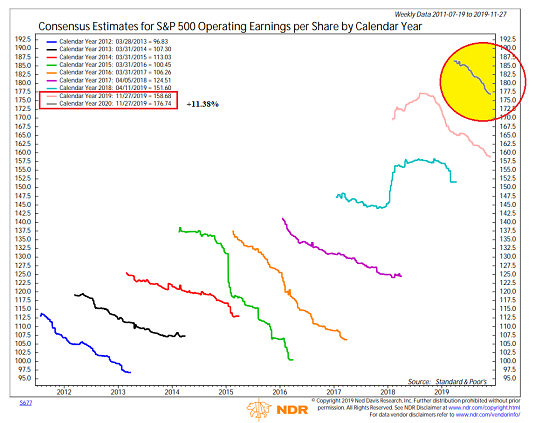
View Chart Online
Source: Ned Davis Research Group
There are several items worthy of note here. First, this chart clearly shows that consensus expectations over the past 8 years have tended to start off way too high. Over time, as reality sets in, the expectations tend to move steadily from the upper left to the lower right. And with the exception of 2018, which saw analysts react to the benefits of the tax cut, the final EPS for the index finished each year well below where the estimates began.
Next, note that with the exception of 2015 (a year that saw an earnings recession caused by the meltdown in the oil patch), year-over-year earnings have risen. And from an uber-simplistic point of view, this can be used to "esplain" why stocks tend to rise during most calendar years.
If you are looking for an explanation of the 2018 debacle that flew in the face of S&P 500 EPS growing from $124.51 to $151.60 in 2018, the answer lies in the shape of 2019's estimate plot. Note that analysts started off expecting earnings to improve smartly in 2019 as estimates were rising. But then the dynamic duo of the trade war with China and the Fed becoming overly tight created a fairly dramatic shift in expectations. And as the uncertainty caused by our friends in Washington grew, the selling began.
The bottom line here is to remember that the stock market is a discounting mechanism for future expectations and thus, stocks tend to look ahead and not back.
The next item of note is that EPS is currently expected to increase by 11.4% in 2020, with the current estimates standing at $176.74. From this number, we can apply a multiple in order to come up with a guesstimate for where the S&P might finish the year. The questions, of course, include: (a) what is the appropriate multiple for the environment and (b) will the decline in estimates continue/get worse?
On the question of whether or not the decline in estimates can be expected to keep moving down and to the right, I'd like to direct your attention to another version of earnings estimates. Instead of using Operating Earnings, which tend to involve a fair amount of "financial engineering," the chart below looks at EPS estimates from a GAAP (generally accepted accounting principles) perspective.
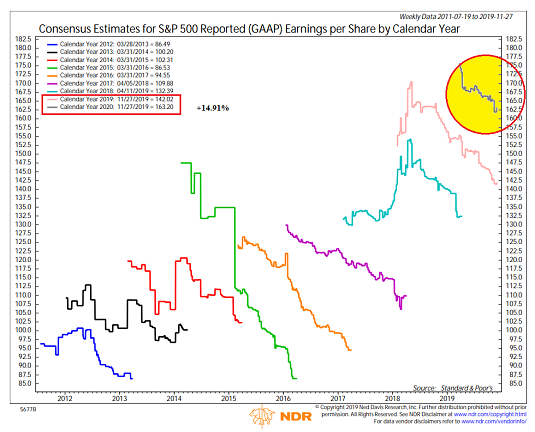
View Chart Online
Source: Ned Davis Research Group
The first thing to note on this chart is that GAAP EPS is currently expected to increase by nearly 15% next year. And from my perch, this could be a decent argument for the current leg of the bull having some room to run.
In addition - and you may need to click on the link to view a larger version of the chart to see this point - I find it interesting that the most recent move in the GAAP estimate plot is up. Although this could certainly prove to be nothing more than a temporary interruption to the downward trend, one could argue that the current pace of downgrades could be slowing. Or not. We shall see.
A Quick Look At Valuations
For those who like to keep score at home, one of the best ways to determine the appropriate multiple to apply to earnings expectations is to look at history.
Below is a chart of the GAAP P/E Ratio going back to 1926. The GAAP P/E currently stands at 23.63, which by historical standards, well, let's just say it isn't cheap. And it is for this reason that our furry friends in the bear camp contend that the valuation of the stock market is stretched.
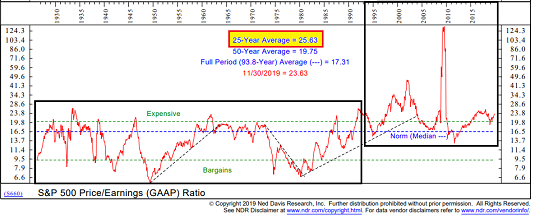
View Chart Online
Source: Ned Davis Research Group
But (again, you had to know that was coming!)... I have long contended that there are really two distinctly different eras on this chart, which I've illustrated below.
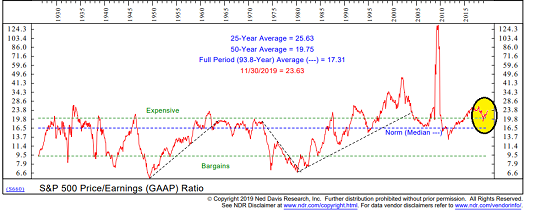
View Chart Online
Source: Ned Davis Research Group
In short, the GAAP P/E of the S&P remained in a tidy range between 6 and 28 for more than 65 years. However, my thinking is that the advent of the 401K as the public's primary retirement savings vehicle and the corresponding constant demand for stocks, changed the game.
For this reason, I've drawn a box around the GAAP P/E from the mid-1990's forward.
Cutting to the chase, the current reading of 23.63 is by no means extreme when viewed in this timeframe. A timeframe that now spans 25+ years, which is getting to be a long time.
Yes, I will agree the spike in 2008-09 was a one-off and should be discounted. And I will also agree that the spike caused by the tech bubble bursting should also be taken with a grain of salt.
My point here is that the average GAAP P/E over the last 25 years is 25.63. And if one eliminates the two outliers, I can argue that a high valuation reading might be somewhere in the 28-30 zone. Or another way to look at the situation is to note that the most recent peak seen in early 2018 was somewhere above 26.
Thus, I will suggest that stocks are not extremely overvalued here when viewed from a GAAP P/E point of view over the past 25 years. And because of this, if investors were to get a positive resolution on the trade front and an uptick in economic activity, I will also argue that additional multiple expansion is possible.
Finally, let me emphasize that stocks don't move in a straight line and that a 10% correction can happen at any time, for just about any reason. But for me, the key is to recognize that there is a path forward to higher stock prices - if we stop shooting ourselves in the foot, of course.
Weekly Market Model Review
Each week we do a disciplined, deep dive into our key market indicators and models. The overall goal of this exercise is to (a) remove emotion from the investment process, (b) stay "in tune" with the primary market cycles, and (c) remain cognizant of the risk/reward environment.
The Major Market Models
We start with six of our favorite long-term market models. These models are designed to help determine the "state" of the overall market.
The are no changes to report on the Primary Cycle board this week. However, there has been a lot of talk lately about this move looking/feeling like a "blow off" top to the current cycle. While anything is possible in this game (personally, I worried more about a blow off top in January 2018), my six favorite big-picture models suggest that the indicators are largely in sync us that the bulls be given the benefit of any doubt at this stage of the game.
This week's mean percentage score of my 6 favorite market models held steady at 75.6% while the median also was unchanged at 75.0%.
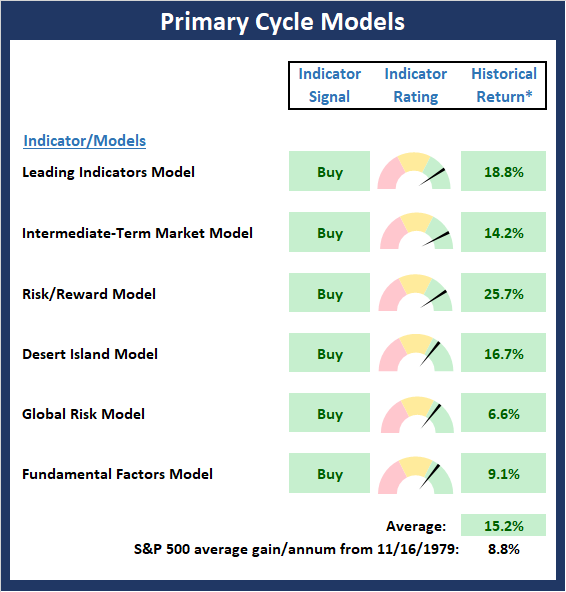
* Source: Ned Davis Research (NDR) as of the date of publication. Historical returns are hypothetical average annual performances calculated by NDR. Past performances do not guarantee future results or profitability - NOT INDIVIDUAL INVESTMENT ADVICE.
View My Favorite Market Models Online
The State of the Fundamental Backdrop
Next, we review the market's fundamental factors in the areas of interest rates, the economy, inflation, and valuations.
Ditto for the Fundamental Factors board as there were no obvious changes again this week. However, there was one modest move within a component indicator that is worthy of note. While the current signal is still "buy" and the rating remains positive, the reading of the Inflation Composite has been moving toward the neutral zone and is currently at the lowest reading since October 2018. To be sure, this is NOT a warning that inflation is becoming a problem. No, my take is more along the lines of the tailwind of low inflation is beginning to wane and that a more neutral environment for inflation expectations MAY be developing. Stay tuned, this could be an important development in the coming months.
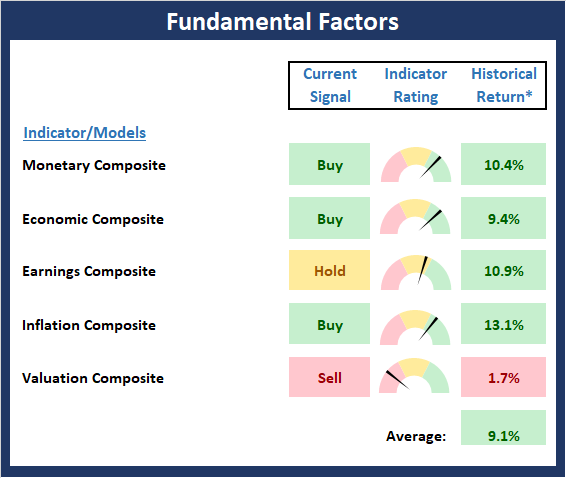
* Source: Ned Davis Research (NDR) as of the date of publication. Historical returns are hypothetical average annual performances calculated by NDR. Past performances do not guarantee future results or profitability - NOT INDIVIDUAL INVESTMENT ADVICE.
View Fundamental Indicator Board Online
The State of the Trend
From there, we look at the state of the current trend. This board of indicators is designed to tell us about the overall technical health of the current trend.
For at least the two weeks prior to last week's report, I had warned that some sort of break in the upside action was likely in the near-term. For example, last week, I wrote that "a pullback, a correction, or at the very least, a pause in the uptrend is to be expected. As such, a test of the trend (and the bulls' resolve) wouldn't surprise anyone at this stage of the game." Right on cue, the President waffled on the trade deal and stocks pulled back about 2.5% in short order (oh and Monday's surprisingly weak manufacturing report didn't help). However, with the narrative/expectations surrounding the next round of tariffs improving and a stunning jobs report, the pullback was largely erased by Friday's close. However, with the chart of the S&P now littered with gaps and resistance overhead, my take is the current trend leans a little more neutral than the Trend board indicates - at least from a short-term perspective.

NOT INDIVIDUAL INVESTMENT ADVICE.
View Trend Indicator Board Online
The State of Internal Momentum
Next, we analyze the "oomph" behind the current trend via our group of market momentum indicators/models.
There can be no arguing that the Momentum board remains in pretty good shape. But (you knew that was coming, right?), when digging into the component indicators, I will note that it wouldn't take much downside action for this board to slip into the neutral zone - again, from a shorter-term perspective. Longer-term, things continue to look solid.
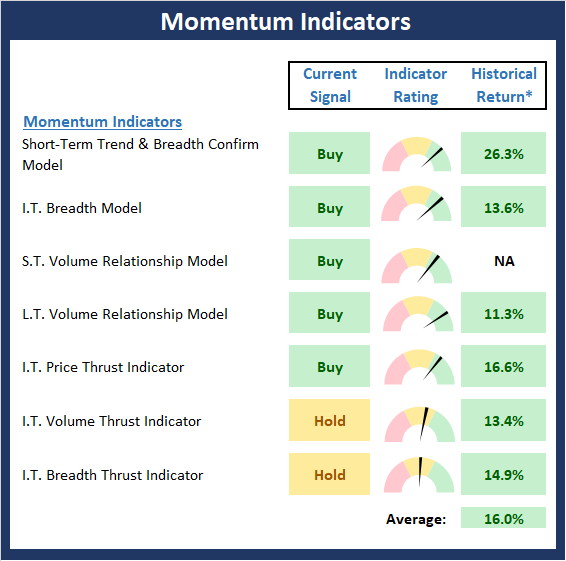
* Source: Ned Davis Research (NDR) as of the date of publication. Historical returns are hypothetical average annual performances calculated by NDR. Past performances do not guarantee future results or profitability - NOT INDIVIDUAL INVESTMENT ADVICE.
View Momentum Indicator Board Online
Early Warning Signals
Once we have identified the current environment, the state of the trend, and the degree of momentum behind the move, we review the potential for a counter-trend move to begin. This batch of indicators is designed to suggest when the table is set for the trend to "go the other way."
With this market tied largely to the headlines on trade, we can't put too much emphasis on the state of our Early Warning indicators. For example, the table had been set nicely for the bears, but some positive headlines turned the tide and the bears didn't get much done with their opportunity. And looking at this week's board, I will argue that the bears' advantage has largely dissipated as the board is now largely neutral. My take is that stocks are likely to remain range-bound until we get clarity on the 12/15 tariff deadline.
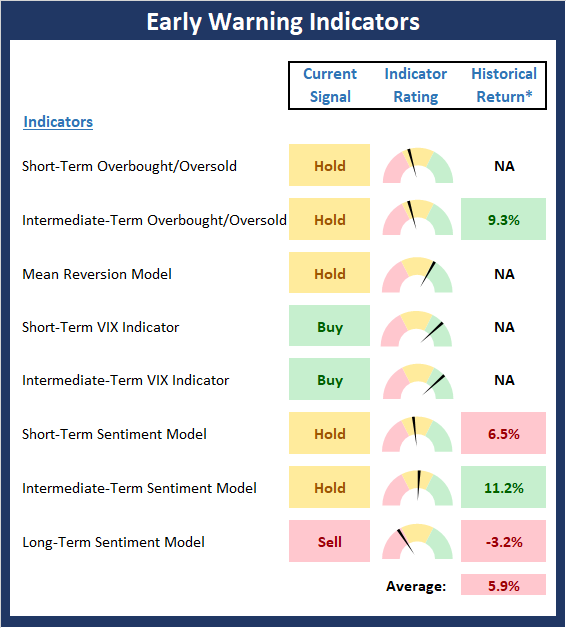
* Source: Ned Davis Research (NDR) as of the date of publication. Historical returns are hypothetical average annual performances calculated by NDR. Past performances do not guarantee future results or profitability - NOT INDIVIDUAL INVESTMENT ADVICE.
View Early Warning Indicator Board Online
Thought For The Day:
I don't mind what Congress does, as long as they don't do it in the streets and frighten the horses. - Victor Hugo
Wishing you green screens and all the best for a great day,

David D. Moenning
Founder, Chief Investment Officer
Heritage Capital Research
Disclosures
At the time of publication, Mr. Moenning held long positions in the following securities mentioned: None - Note that positions may change at any time.
Leading Indicators Model: A group of indicators that have historically shown tendencies to lead the market at major turning points.
Intermediate-Term Market Model: A composite model (model of models) focused on trend and momentum indicators which has been designed to provide identify intermediate-term trading opportunities.
Risk/Reward Model: A model-of-models intended to provide an overall view of the state of the risk/reward environment. The model includes tape, monetary, and sentiment indicators as well as 7 big-picture market model readings.
Desert Island Model: If I was stranded on a desert island with access to only one market model to manage money with, this would be the model. The model is a comprehensive model-of-models comprised of trend, momentum, mean reversion, economic, monetary, sentiment, and factor-based indicators/models.
External Factors Model: A model-of-models designed to provide a reading on the "macro state" of the market environment. The model is comprised of indicators/models in the areas of various index yields, industrial production, investors sentiment, and historic volatility.
Short-Term Trend-and-Breadth Signal Explained: History shows the most reliable market moves tend to occur when the breadth indices are in gear with the major market averages. When the breadth measures diverge, investors should take note that a trend reversal may be at hand. This indicator incorporates NDR's All-Cap Dollar Weighted Equity Series and A/D Line. From 1998, when the A/D line is above its 5-day smoothing and the All-Cap Equal Weighted Equity Series is above its 25-day smoothing, the equity index has gained at a rate of +32.5% per year. When one of the indicators is above its smoothing, the equity index has gained at a rate of +13.3% per year. And when both are below, the equity index has lost +23.6% per year.
Channel Breakout System Explained: The short-term and intermediate-term Channel Breakout Systems are modified versions of the Donchian Channel indicator. According to Wikipedia, "The Donchian channel is an indicator used in market trading developed by Richard Donchian. It is formed by taking the highest high and the lowest low of the last n periods. The area between the high and the low is the channel for the period chosen."
Intermediate-Term Trend-and-Breadth Signal Explained: This indicator incorporates NDR's All-Cap Dollar Weighted Equity Series and A/D Line. From 1998, when the A/D line is above its 45-day smoothing and the All-Cap Equal Weighted Equity Series is above its 45-day smoothing, the equity index has gained at a rate of +17.6% per year. When one of the indicators is above its smoothing, the equity index has gained at a rate of +6.5% per year. And when both are below, the equity index has lost -1.3% per year.
Cycle Composite Projections: The cycle composite combines the 1-year Seasonal, 4-year Presidential, and 10-year Decennial cycles. The indicator reading shown uses the cycle projection for the upcoming week.
Trading Mode Indicator: This indicator attempts to identify whether the current trading environment is "trending" or "mean reverting." The indicator takes the composite reading of the Efficiency Ratio, the Average Correlation Coefficient, and Trend Strength models.
Volume Relationship Models: These models review the relationship between "supply" and "demand" volume over the short- and intermediate-term time frames.
Price Thrust Model Explained: This indicator measures the 3-day rate of change of the Value Line Composite relative to the standard deviation of the 30-day average. When the Value Line's 3-day rate of change have moved above 0.5 standard deviation of the 30-day average ROC, a "thrust" occurs and since 2000, the Value Line Composite has gained ground at a rate of +20.6% per year. When the indicator is below 0.5 standard deviation of the 30-day, the Value Line has lost ground at a rate of -10.0% per year. And when neutral, the Value Line has gained at a rate of +5.9% per year.
Volume Thrust Model Explained: This indicator uses NASDAQ volume data to indicate bullish and bearish conditions for the NASDAQ Composite Index. The indicator plots the ratio of the 10-day total of NASDAQ daily advancing volume (i.e., the total volume traded in stocks which rose in price each day) to the 10-day total of daily declining volume (volume traded in stocks which fell each day). This ratio indicates when advancing stocks are attracting the majority of the volume (readings above 1.0) and when declining stocks are seeing the heaviest trading (readings below 1.0). This indicator thus supports the case that a rising market supported by heavier volume in the advancing issues tends to be the most bullish condition, while a declining market with downside volume dominating confirms bearish conditions. When in a positive mode, the NASDAQ Composite has gained at a rate of +38.3% per year, When neutral, the NASDAQ has gained at a rate of +13.3% per year. And when negative, the NASDAQ has lost at a rate of -14.279% per year.
Breadth Thrust Model Explained: This indicator uses the number of NASDAQ-listed stocks advancing and declining to indicate bullish or bearish breadth conditions for the NASDAQ Composite. The indicator plots the ratio of the 10-day total of the number of stocks rising on the NASDAQ each day to the 10-day total of the number of stocks declining each day. Using 10-day totals smooths the random daily fluctuations and gives indications on an intermediate-term basis. As expected, the NASDAQ Composite performs much better when the 10-day A/D ratio is high (strong breadth) and worse when the indicator is in its lower mode (weak breadth). The most bullish conditions for the NASDAQ when the 10-day A/D indicator is not only high, but has recently posted an extreme high reading and thus indicated a thrust of upside momentum. Bearish conditions are confirmed when the indicator is low and has recently signaled a downside breadth thrust. In positive mode, the NASDAQ has gained at a rate of +22.1% per year since 1981. In a neutral mode, the NASDAQ has gained at a rate of +14.5% per year. And when in a negative mode, the NASDAQ has lost at a rate of -6.4% per year.
Short-Term Overbought/sold Indicator: This indicator is the current reading of the 14,1,3 stochastic oscillator. When the oscillator is above 80 and the %K is above the %D, the indicator gives an overbought reading. Conversely, when the oscillator is below 20 and %K is below its %D, the indicator is oversold.
Intermediate-Term Overbought/sold Indicator: This indicator is a 40-day RSI reading. When above 57.5, the indicator is considered overbought and wnen below 45 it is oversold.
Mean Reversion Model: This is a diffusion model consisting of five indicators that can produce buy and sell signals based on overbought/sold conditions.
VIX Indicator: This indicators looks at the current reading of the VIX relative to standard deviation bands. When the indicator reaches an extreme reading in either direction, it is an indication that a market trend could reverse in the near-term.
Short-Term Sentiment Indicator: This is a model-of-models composed of 18 independent sentiment indicators designed to indicate when market sentiment has reached an extreme from a short-term perspective. Historical analysis indicates that the stock market's best gains come after an environment has become extremely negative from a sentiment standpoint. Conversely, when sentiment becomes extremely positive, market returns have been subpar.
Intermediate-Term Sentiment Indicator: This is a model-of-models composed of 7 independent sentiment indicators designed to indicate when market sentiment has reached an extreme from a intermediate-term perspective. Historical analysis indicates that the stock market's best gains come after an environment has become extremely negative from a sentiment standpoint. Conversely, when sentiment becomes extremely positive, market returns have been subpar.
Long-Term Sentiment Indicator: This is a model-of-models composed of 6 independent sentiment indicators designed to indicate when market sentiment has reached an extreme from a long-term perspective. Historical analysis indicates that the stock market's best gains come after an environment has become extremely negative from a sentiment standpoint. Conversely, when sentiment becomes extremely positive, market returns have been subpar.
Absolute Monetary Model Explained: The popular cliche, "Don't fight the Fed" is really a testament to the profound impact that interest rates and Fed policy have on the market. It is a proven fact that monetary conditions are one of the most powerful influences on the direction of stock prices. The Absolute Monetary Model looks at the current level of interest rates relative to historical levels and Fed policy.
Relative Monetary Model Explained: The "relative" monetary model looks at monetary indicators relative to recent levels as well as rates of change and Fed Policy.
Economic Model Explained: During the middle of bull and bear markets, understanding the overall health of the economy and how it impacts the stock market is one of the few truly logical aspects of the stock market. When our Economic model sports a "positive" reading, history (beginning in 1965) shows that stocks enjoy returns in excess of 21% per year. Yet, when the model's reading falls into the "negative" zone, the S&P has lost nearly -25% per year. However, it is vital to understand that there are times when good economic news is actually bad for stocks and vice versa. Thus, the Economic model can help investors stay in tune with where we are in the overall economic cycle.
Inflation Model Explained: They say that "the tape tells all." However, one of the best "big picture" indicators of what the market is expected to do next is inflation. Simply put, since 1962, when the model indicates that inflationary pressures are strong, stocks have lost ground. Yet, when inflationary pressures are low, the S&P 500 has gained ground at a rate in excess of 13%. The bottom line is inflation is one of the primary drivers of stock market returns.
Valuation Model Explained: If you want to get analysts really riled up, you need only to begin a discussion of market valuation. While the question of whether stocks are overvalued or undervalued appears to be a simple one, the subject is actually extremely complex. To simplify the subject dramatically, investors must first determine if they should focus on relative valuation (which include the current level of interest rates) or absolute valuation measures (the more traditional readings of Price/Earnings, Price/Dividend, and Price/Book Value). We believe that it is important to recognize that environments change. And as such, the market's focus and corresponding view of valuations are likely to change as well. Thus, we depend on our Valuation Models to help us keep our eye on the ball.
Disclosures
NOT INVESTMENT ADVICE. The opinions and forecasts expressed herein are those of Mr. David Moenning and Heritage Capital Research and may not actually come to pass. The opinions and viewpoints regarding the future of the markets should not be construed as recommendations. The analysis and information in this report is for informational purposes only. No part of the material presented in this report is intended as an investment recommendation or investment advice. Neither the information nor any opinion expressed constitutes a solicitation to purchase or sell securities or any investment program.
Any investment decisions must in all cases be made by the reader or by his or her investment adviser. Do NOT ever purchase any security without doing sufficient research. There is no guarantee that the investment objectives outlined will actually come to pass. All opinions expressed herein are subject to change without notice. Neither the editor, employees, nor any of their affiliates shall have any liability for any loss sustained by anyone who has relied on the information provided.
Mr. Moenning of Heritage Capital Research is an investment adviser representative of Eastsound Capital Advisors, LLC, a registered investment advisor. The adviser may not transact business in states where it is not appropriately registered, excluded or exempted from registration. Individualized responses to persons that involve either the effecting of transaction in securities, or the rendering of personalized investment advice for compensation, will not be made without registration or exemption.
Mr. Moenning and Heritage Capital Research may at times have positions in the securities referred to and may make purchases or sales of these securities while publications are in circulation. Positions may change at any time.
The analysis provided is based on both technical and fundamental research and is provided "as is" without warranty of any kind, either expressed or implied. Although the information contained is derived from sources which are believed to be reliable, they cannot be guaranteed.
The author neither endorses nor warrants the content of this site, any embedded advertisement, or any linked resource. The author or his managed funds may hold either long or short positions in the referenced securities. Republication rights must be expressly granted by author in writing.
Investments in equities carry an inherent element of risk including the potential for significant loss of principal. Past performance is not an indication of future results.

